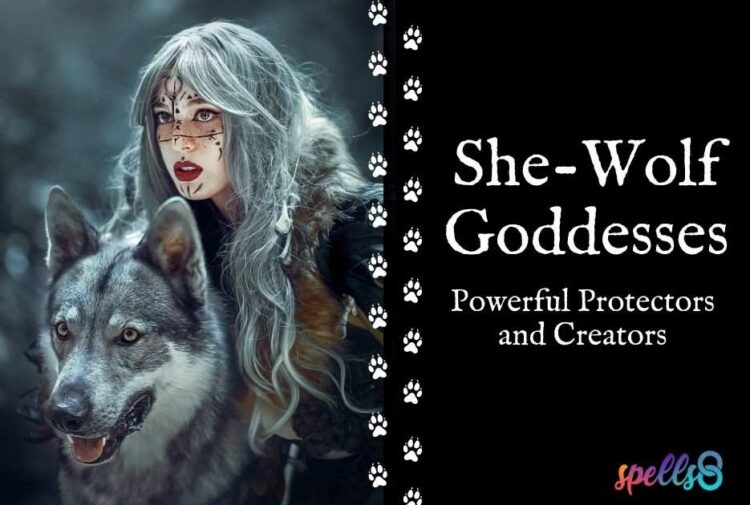Throughout history, the wolf has been a symbol of power, strength, and independence, but what about its feminine counterpart? The divine she-wolf is a figure that appears in many cultures and mythologies worldwide, from Greek mythology to Native American folklore. Here we will explore these fascinating figures and unpack the symbolism behind them. From fierce protectors to wise guides, discover how these wolf goddesses have left their mark on our collective consciousness.

Origins of Wolf Goddesses in Folklore and Legend
In ancient times, wolves were revered as sacred animals and seen as symbols of strength, courage, and wisdom. The wolf was also depicted as a guardian of the natural world and a protector of humans.
The goddesses who were associated with wolves often had characteristics that mirrored those of the animal. They were powerful, independent, and sometimes fierce. But they were also loving, nurturing, and devoted to their families and communities.
The origins of these goddesses can be traced back to the early days of human history. In some cultures, they date back to the Stone Age. In others, they are part of the mythological traditions of indigenous peoples. These goddesses often take on the form of a wolf or woman, and their tales typically revolve around themes of protection, fertility, and motherhood.

While the specifics of each story vary, there are some common threads that run through many of them. For example, wolf goddesses are often associated with the moon and are often depicted as having healing powers. In some stories, they also serve as guides or protectors for humans who find themselves in danger.
Wolf goddesses are often seen as protectors of their pack and use their wisdom and strength to guide them through difficult times. They are also associated with fertility and motherhood. In some cultures, wolf goddesses are the bringers of life.
Wolf Goddesses from Around the World
1. Diana
The Roman goddess Diana was associated with wolves. She was the goddess of hunting and the moon and was known as a protector of women and children. Her Greek equivalent was Artemis, and both ruled the forest and the wildlife within, including wolves. And now, as associations are made with wolves and the ‘wild’ woman, taking us back to our primal nature, Diana’s links with wildlife and woman make her connection to wolves more obvious.

This Diana of the Moon Incense DIY recipe is great for working with any type of lunar magic. Best if made on a Monday or under a Full Moon.
2. Lupa
The Goddess Lupa was a she-wolf who nursed the twins Romulus and Remus after they had been abandoned. (Romulus would later become the founder and first king of Rome.) A formidable individual, Lupa was a wolf goddess who brought death and destruction to her enemies or provided protection and prosperity to those she cared about.

3. Medeina
The Lithuanian goddess Medeina is described as a beautiful huntress unwilling to get married and portrayed as a she-wolf who traveled with an escort of wolves.

4. Cailleach
In Scotland, a goddess known as Cailleach is often associated with wolves. She is portrayed riding a running wolf and bears a hammer or wand made of human flesh. She brings destruction and winter with her and rules the dark half of the year. While she is depicted as a destroyer, she is also a protector of wild things, such as the wolf.

5. Asena
The wolf is held in high regard in Turkey. In a similar light to the Romans, the she-wolf known as Asena, became the mother of the great Khans. The story goes that she rescued an injured boy and nursed him back to health. Then she bore him ten half-wolf half-human children, the eldest of which became the chieftain of the Turkic tribes.

6. Morrígan
The Celtic goddess Morrígan has sometimes been shown as a wolf. She has connections with the wolf and the cow, which suggests that in some areas, she was linked to fertility and the land. Primarily known as a warrior goddess, she is also linked to sovereignty and kingship.

Morrígan: Goddess Offerings, Signs, Symbols & Myth
7. Nehalennia
A lesser-known Celtic wolf goddess from the first and second centuries is Nehalennia. She comes from the area of Netherlands, Sweden, and the islands off the coast of Europe. Nehalennia has a wolf-hound at her feet, carries a basket of fruit or bread, and is shown with the symbols of the sea. She is associated with the harvest, fertility, the ocean, trading, horticulture, and wolves.

8. Leto
In Greek mythology, we have the story of the original Greek wolf goddess, Leto. As a goddess of womanhood and motherhood, Leto gave birth to twins Artemis and Apollo. Legend has it that Leto labored for twelve days to deliver the twins, corresponding to the time it took in Greek mythology for wolves to deliver their young.

Leto’s journey from the Hyperboreoi to Delos took the same amount of time. She can also shift into the form of a wolf. All these similarities show how she became one of the Greek wolf goddesses.
See also: Greco-Roman Deity Masterpost – Spells8 Forum
9. Skadi
In ancient Scandinavia, we find the Norse Goddess of Winter, Skadi. Skadi is a Giantess and often has wolves at her side. When he stays in the mountains with her, her husband Njord complains that the howling of the wolves keeps him awake at night. Skadi, however, doesn’t mind the sound; she welcomes the howling. She is one of the wolf pack and guards her mountains as her sacred home.

See also: ‘Howling at the Moon’: Wolf Goddess Skadi Manifestation Spell
How Different Cultures Perceive Wolf Goddesses
Wolf goddesses are present in the folklore of many cultures around the world. Each culture has its own unique take on these powerful figures.
In Native American folklore, there are many stories about wolf goddesses. One popular legend is that of the White Wolf Woman. She is said to be a kind and helpful spirit who helps lost travelers find their way home. Another Native American legend tells the story of Sleeping Woman, a wolf goddess who brings peace and healing to those sick or injured.

Many Native American tribes tell stories of wolves who became role models as they taught the people how to hunt. These stories often involved mutual support between humans and wolves.
In Japan, grain farmers once worshiped wolves at shrines and left food near their dens, asking for the wolves’ help in protecting their crops from wild boar and deer. Talismans adorned with images of wolves were thought to protect against fire, disease, and other destructions.
The Power and Strength of Female Wolves
Female wolves are often revered in folklore and legend for their power and strength. In many cultures, the wolf is seen as a symbol of femininity, and women are often associated with wolves. In some stories, female wolves are portrayed as powerful goddesses who can protect and provide for their pack. Others see them as dangerous and destructive creatures who should be avoided.
Some folktales portray female wolves as kind and benevolent mothers who care for their young. Others depict them as fierce warriors who defend their packs from danger. Female wolves are often seen as symbols of strength, power, and protection, regardless of how they are portrayed.

Over time, the representation of wolf goddesses has evolved. In modern times, they are often seen as symbols of strength, independence, and power. They are also often associated with feminism and environmentalism.
Wolf goddesses in folklore have served as powerful symbols of the feminine divine, representing strength and protection. They remind us that women can be both nurturing and fierce, embodying a balance between light and dark. Wolf goddesses are indeed remarkable creatures who deserve appreciation and reverence.






